Hydrogen-Deuterium Exchange Supports Independent Membrane-Interfacial Fusion Peptide and Transmembrane Domains in Subunit 2 of Influenza Virus Hemagglutinin Protein, a Structured and Aqueous-Protected Connection between the Fusion Peptide and Soluble Ectodomain, and the Importance of Membrane Apposition by the Trimer-of-Hairpins Structure
- PMID: 31008587
- PMCID: PMC6536117
- DOI: 10.1021/acs.biochem.8b01272
Hydrogen-Deuterium Exchange Supports Independent Membrane-Interfacial Fusion Peptide and Transmembrane Domains in Subunit 2 of Influenza Virus Hemagglutinin Protein, a Structured and Aqueous-Protected Connection between the Fusion Peptide and Soluble Ectodomain, and the Importance of Membrane Apposition by the Trimer-of-Hairpins Structure
Abstract
The influenza virus hemagglutinin (HA) protein has HA1 and HA2 subunits, which form an initial complex. HA1's bind host cell sialic acids, which triggers endocytosis, HA1/HA2 separation, and HA2-mediated fusion between virus and endosome membranes. We report hydrogen-deuterium exchange mass spectrometry (HDX-MS) on the HA2 subunit without HA1. HA2 contains the fusion peptide (FP), soluble ectodomain (SE), transmembrane domain (TM), and endodomain. FP is a monomer by itself, while SE is a trimer of hairpins that includes an interior bundle of residue 38-105 helices, turns, and residue 154-178 strands packed antiparallel to the bundle. FP and TM extend from the same side of the SE hairpin, and fusion models often depict a FP/TM complex with membrane traversal of both domains that is important for membrane pore expansion. The HDX-MS data of this study do not support this complex and instead support independent FP and TM with respective membrane-interfacial and traversal locations. The data also show a low level of aqueous exposure of the 22-38 segment, consistent with retention of the 23-35 antiparallel β sheet observed in the initial HA1/HA2 complex. We propose the β sheet as a semirigid connector between FP and SE that enables close membrane apposition prior to fusion. The I173E mutant exhibits greater exchange for residues 22-69 and 150-191, consistent with dissociation of SE C-terminal strands from interior N-helices. Similar trends are observed for the G1E mutant as well as less exchange for G1E FP. Fusion is highly impaired with either mutant, which correlates with reduced membrane apposition and, for G1E, FP binding to SE rather than the target membrane.
Figures
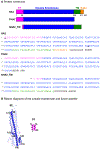
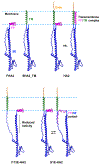

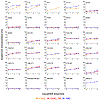
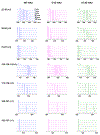
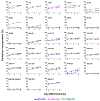
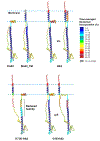

Similar articles
-
The Stabilities of the Soluble Ectodomain and Fusion Peptide Hairpins of the Influenza Virus Hemagglutinin Subunit II Protein Are Positively Correlated with Membrane Fusion.Biochemistry. 2018 Sep 18;57(37):5480-5493. doi: 10.1021/acs.biochem.8b00764. Epub 2018 Sep 5. Biochemistry. 2018. PMID: 30141905 Free PMC article.
-
Full-length trimeric influenza virus hemagglutinin II membrane fusion protein and shorter constructs lacking the fusion peptide or transmembrane domain: Hyperthermostability of the full-length protein and the soluble ectodomain and fusion peptide make significant contributions to fusion of membrane vesicles.Protein Expr Purif. 2016 Jan;117:6-16. doi: 10.1016/j.pep.2015.08.021. Epub 2015 Aug 19. Protein Expr Purif. 2016. PMID: 26297995 Free PMC article.
-
Intermonomer Interactions in Hemagglutinin Subunits HA1 and HA2 Affecting Hemagglutinin Stability and Influenza Virus Infectivity.J Virol. 2015 Oct;89(20):10602-11. doi: 10.1128/JVI.00939-15. Epub 2015 Aug 12. J Virol. 2015. PMID: 26269180 Free PMC article.
-
Composition and functions of the influenza fusion peptide.Protein Pept Lett. 2009;16(7):766-78. doi: 10.2174/092986609788681715. Protein Pept Lett. 2009. PMID: 19601906 Review.
-
Structural biology of the influenza virus fusion peptide.Acta Biochim Pol. 2014;61(3):421-6. Epub 2014 Sep 8. Acta Biochim Pol. 2014. PMID: 25195144 Review.
Cited by
-
A large HIV gp41 construct with trimer-of-hairpins structure exhibits V2E mutation-dominant attenuation of vesicle fusion and helicity very similar to V2E attenuation of HIV fusion and infection and supports: (1) hairpin stabilization of membrane apposition with larger distance for V2E; and (2) V2E dominance by an antiparallel β sheet with interleaved fusion peptide strands from two gp41 trimers.Biophys Chem. 2023 Feb;293:106933. doi: 10.1016/j.bpc.2022.106933. Epub 2022 Nov 24. Biophys Chem. 2023. PMID: 36508984 Free PMC article.
-
Influenza A H1 and H3 Transmembrane Domains Interact Differently with Each Other and with Surrounding Membrane Lipids.Viruses. 2020 Dec 17;12(12):1461. doi: 10.3390/v12121461. Viruses. 2020. PMID: 33348831 Free PMC article.
-
Advances in Hydrogen/Deuterium Exchange Mass Spectrometry and the Pursuit of Challenging Biological Systems.Chem Rev. 2022 Apr 27;122(8):7562-7623. doi: 10.1021/acs.chemrev.1c00279. Epub 2021 Sep 7. Chem Rev. 2022. PMID: 34493042 Free PMC article. Review.
-
Mass Spectrometry-Based Structural Virology.Anal Chem. 2021 Jan 12;93(1):620-640. doi: 10.1021/acs.analchem.0c04339. Epub 2020 Dec 4. Anal Chem. 2021. PMID: 33275424 Free PMC article. Review. No abstract available.
-
2H nuclear magnetic resonance spectroscopy supports larger amplitude fast motion and interference with lipid chain ordering for membrane that contains β sheet human immunodeficiency virus gp41 fusion peptide or helical hairpin influenza virus hemagglutinin fusion peptide at fusogenic pH.Biochim Biophys Acta Biomembr. 2020 Oct 1;1862(10):183404. doi: 10.1016/j.bbamem.2020.183404. Epub 2020 Jun 23. Biochim Biophys Acta Biomembr. 2020. PMID: 32585207 Free PMC article.
References
-
- Boonstra S, Blijleven JS, Roos WH, Onck PR, van der Giessen E, and van Oijen AM (2018) Hemagglutinin-mediated membrane fusion: A biophysical perspective, Ann. Revs. Biophys 47, 153–173. - PubMed
-
- Nobusawa E, Aoyama T, Kato H, Suzuki Y, Tateno Y, and Nakajima K (1991) Comparison of complete amino acid sequences and receptor binding properties among 13 serotypes of hemagglutinins of influenza A viruses, Virology 182, 475–485. - PubMed
-
- Wilson IA, Skehel JJ, and Wiley DC (1981) Structure of the haemagglutinin membrane glycoprotein of influenza virus at 3 A resolution, Nature 289, 366–373. - PubMed
Publication types
MeSH terms
Substances
Grants and funding
LinkOut - more resources
Full Text Sources
Research Materials
Miscellaneous

